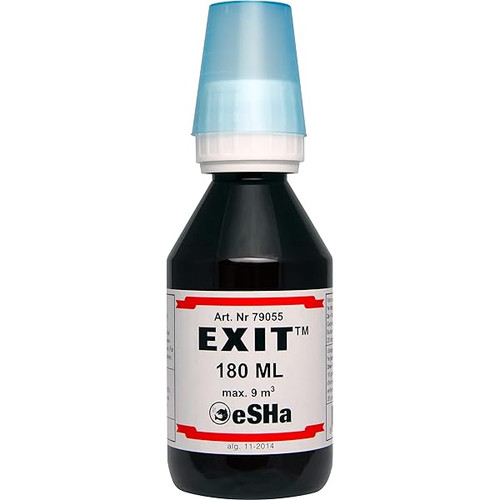eSHa EXIT highly effective against all known forms of Ichthyo (freshwater)
When to use eSHa EXIT?
Making the correct diagnosis is often the key to rapid success
healing. Many fish diseases are highly contagious and spread
quickly into the aquarium water. It is also very important that you are fast
can treat. There are early signs that you suspect if
something is wrong with your fish.
Skin: the skin is the first protection and defense system and shows
usually also the first sign of a disease or deficiency due to an infection. You should keep a close eye on any coloring.
Fins: Pay attention to the fins. If it is close to the body of the
fish are often attributed this to a disease or deficiency. Especially with
viviparous fish.
Swimming behavior: Unusual swimming behavior or rocking can be indicative of the presence of a disease.
Which fish can be treated with eSHa EXIT?
Tropical fish ✔
Cold water fish ✔
Saltwater fish ✘
EXIT is safe for fish, plants and filters if dosed correctly.
EXIT gives excellent results, especially with tropical fish.
Application areas
EXIT treats all forms of ‘dot’ (Ichthyo). EXIT distinguishes itself from other products by combating pepper spot (Oodinium). This is a great advantage because the two parasites are often confused with each other. This prevents EXIT from choosing the wrong remedy.
The table below lists the specific pathogens that EXIT eliminates.
DISEASE SYMPTOMS
1 Small white dots on the body and fins of the fish. The fish tends to rub against objects such as aquarium decoration.
NAME OF THE DISEASE
‘White dot’ – also called ‘ichthyo’
or “dot” (Ichthyophthirius multifiliis). This is one of the most
known problems among aquarium owners. Virtually all freshwater fish are affected.
2 The fish may have breathing problems (rapid gill movements). The fish is covered with
a gray and tan haze. This haze looks dotted at first and resembles many tiny gold dots. The fish will probably try to “scratch” around the aquarium decoration. There may be mucus all over the body.
NAME OF THE DISEASE
‘Pepperspot’ – (Oodinium pillularis). Fatal for boy. This disease is less well known than the common ‘white spot’, so the symptoms are often confused. Because EXIT treats both forms of dot, the danger of choosing the wrong remedy has passed.
EXIT solves the problem of misdiagnosis.
EXIT also treats the lesser-known import spot (coarse white spot), pepper spot, black spot and the
coarse dot. These infections are often highly contagious and can spread easily. The sooner you start treating your fish, the better their chance of recovery.
Should I be careful when diagnosing these symptoms?
Yes, some caution is needed when making the diagnosis. This is because some fish, in the
particularly clown botias, can show a white dot as a result of poor water quality
and not due to an infectious disease.
Also, some male fish, especially goldfish, may have white spots around them
the gills and pectoral fins during the mating season. These bulges are not to be confused with white spot.
Dosage
To treat the symptoms of the disease as described above; then use one
standard three days of treatment to start. With a multi-day dose you achieve exceptional results
results, while minimizing discomfort to your fish. For more exceptional syndromes, use the “SPECIAL DOSAGE”.
1 Calculate the volume of your aquarium. Calculate only the area filled with water.
2 Find your aquarium volume on the dosage scale. Read down for the corresponding
number of drops needed for days one, two and three.
Please note: the dosage for days 2 and 3 is identical.
3 Dose the drops of EXIT in the aquarium by turning the bottle upside down and gently pouring it into the
dropper to squeeze (20 drops = 1 ml). There should be a visible improvement within 1-2 days.
Standard dosage (for 100 liters)
Day 1 :- 20 drops
Day 2 :- 10 drops
Day 3 :- 10 drops
A bottle of EXIT (20 ml) is sufficient for a 3-day cure for 1000 liters.
Special dosages
There are very resistant species (such as the import dot) where it is necessary to dose longer on a 4th and 5th day.
How long you should dose depends on the nature of the infection.
Following the standard course, add 10 drops per 100 liters on day 4 and day 5.







